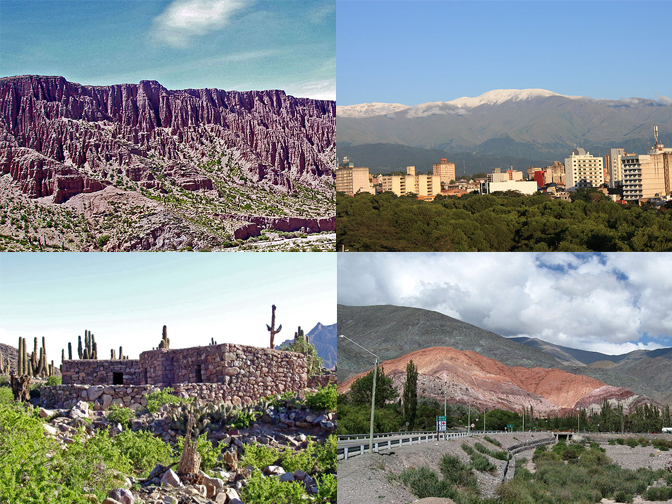Facts for Kids
Jujuy Province is a colorful and beautiful area in northwest Argentina, known for the Andes mountains, rich culture, and diverse wildlife.
Overview
History
Flora And Fauna
Tourism Attractions
Festivals And Events
Geography And Climate
Culture And Traditions
Education And Research
Indigenous Communities
Economy And Agriculture

Inside this Article
Traditional Folk Music
San Salvador De Jujuy
World Heritage Site
Andean Condor
Argentina
Livestock
Province
Quechua
Culture
Science
Did you know?
🇦🇷 Jujuy Province is located in the northwest corner of Argentina.
🏔️ The Andes mountains, the longest mountain range in the world, run through Jujuy.
🌈 One of the province's famous sights is the Hill of Seven Colors.
🗺️ Jujuy shares borders with Chile and Bolivia.
🌄 The Quebrada de Humahuaca is a UNESCO World Heritage site known for its colorful rocks.
⚔️ Jujuy has a rich history with indigenous peoples and Spanish explorers.
🎶 The culture of Jujuy includes traditional folk music and vibrant festivals.
🌾 Agriculture, especially fruit farming, plays an essential role in Jujuy's economy.
🔋 Jujuy is rich in minerals, particularly lithium, used in batteries.
🌿 The province is home to unique flora and fauna, including cacti and the Andean condor.
Introduction
️ The capital city is San Salvador de Jujuy. The province is home to many traditional festivals, delicious foods, and friendly people. People here speak Spanish and belong to diverse cultures. It’s also a place where you can see fantastic sights like the Hill of Seven Colors! 🌈
Jujuy is a wonderful place for adventures and learning about history!
History
️ The area was first inhabited by indigenous peoples like the Tilcara and the Omaguaca, who built villages thousands of years ago. The Spanish arrived in the 16th century, led by explorers like Francisco de Argañarás. ⚔
️ Jujuy played a vital role during Argentina's fight for independence from Spanish rule. The province was established as a province in 1814. The famous General Manuel Belgrano led troops through here. Today, people remember these important historical figures through celebrations and stories! 📜
Jujuy’s history is colorful and full of excitement!
Flora And Fauna
Thanks to its diverse climate, you can find many different types of flora. In mountainous areas, you’ll see cacti, flowering shrubs, and massive trees called "algorobos." 🌵 The Andean condor, one of the largest flying birds, soars in the sky! 🦅
You might also spot llamas and vicuñas grazing on the grasslands. Many colorful butterflies and insects live here too! 🦋
The rich variety in plants and animals makes Jujuy an exciting place for nature lovers and explorers!
Tourism Attractions
One popular spot is the Quebrada de Humahuaca, where you can see stunning rock formations and colorful hills! Many visitors love to hike the trails and see ancient ruins, like Pucará de Tilcara. 🏰
There's also the Salinas Grandes, a vast salt flat that looks like a sparkling white desert! Another must-visit is the Hill of Seven Colors in Purmamarca. 🌈
Jujuy is famous for its traditional festivals and warm hospitality. Families can enjoy fun activities and learn more about this exciting province!
Festivals And Events
One of the most famous is the Carnaval de Humahuaca, where people dance, wear vibrant costumes, and enjoy delicious food! 🎭
Another exciting event is the Fiesta de la Pachamama, which honors Mother Earth with rituals and offerings. This festival takes place in August. 🎊
Jujuy also celebrates traditional religious holidays, including colorful parades! Each festival represents the rich culture and heritage of the province. People of all ages can come together to have fun, share stories, and enjoy incredible experiences in Jujuy! 🌟
Geography And Climate
️ The landscape is full of stunning mountains, high plateaus, and valleys. The Quebrada de Humahuaca is a UNESCO World Heritage site and is famous for its colorful rock formations! 🌄
The temperature varies a lot. In summer, it can be warm, around 30°C (86°F), while in winter, it can get quite cold, down to -5°C (23°F). 🌨
️ The unique geography and climate make Jujuy a special place for various plants and animals!
Culture And Traditions
People here love music and dance, especially the traditional folk music called "zamba!" 🎤 Festivals are essential, like the Carnaval de Humahuaca, where people dress in bright costumes and dance through the streets! 🎭
Art is also popular, and you can find local crafts in markets. Traditional foods include empanadas, tamales, and locro, a hearty stew. Community and family gatherings are essential, and people celebrate their heritage by sharing stories and songs! What a lovely culture to explore!
Education And Research
Education is very important in the province, with many children attending school. The Jujuy University offers exciting programs for higher education! 🏫
Students can study subjects like science, history, and art. Research about local wildlife and plants helps protect the environment. There are projects focused on preserving indigenous culture and languages. 🗣
️ Jujuy's commitment to education and research encourages everyone to explore and discover the wonders of learning every day!
Indigenous Communities
These communities have lived in the region for thousands of years, preserving their languages, customs, and traditions. They celebrate their heritage through art, music, and festivals. 🎨
Many indigenous people farm the land and raise animals, passing down their skills from generation to generation. Their strong connection to nature helps keep their culture alive! Families can learn from these wonderful communities about their unique stories and traditions while visiting Jujuy!
Economy And Agriculture
The province is famous for producing delicious fruits like grapes, apples, and peaches. Agriculture is important because it provides jobs for many families. 🌱
Mining is also a vital part of Jujuy's economy. The province has rich mineral deposits, especially lithium, which is used in batteries for smartphones and electric cars! 🔋
This mining helps support the economy too. Livestock farming is common, with people raising goats and sheep. The mix of farming and mining makes Jujuy's economy unique!

